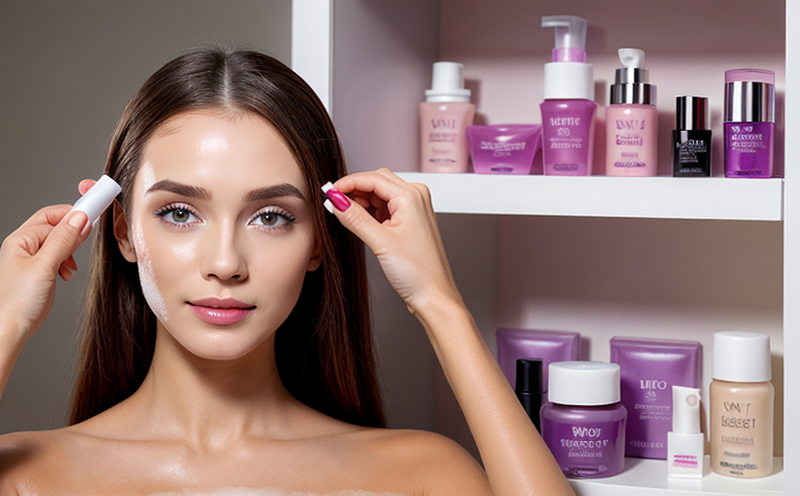Microbiological Quality Testing of Cosmetic Products
The microbiological quality testing of cosmetic products is a critical process in ensuring product safety and maintaining consumer trust. This testing ensures that the products are free from harmful microorganisms, which can cause infections or allergic reactions. The procedure involves several steps including sample collection, preparation, inoculation on selective media, incubation, and identification of viable colonies.
Microbiological quality is a key factor in determining the safety and efficacy of cosmetic products. It helps to identify potential pathogens that may be present in the product, thereby ensuring compliance with regulatory requirements such as ISO 22716:2013 for personal care products or the FDA’s current good manufacturing practices (cGMP).
The testing process typically involves sampling the product at various stages of production. Samples are then prepared and inoculated onto appropriate selective media, which supports the growth of specific types of microorganisms. Commonly used media include Tryptic Soy Agar (TSA), Neutral Red Agar for yeasts and molds, or Violet Red Bile Agar (VRBA) for certain bacteria. The samples are incubated at controlled temperatures to allow for the growth of viable colonies.
Once grown, the colonies are identified based on their morphological characteristics such as color, texture, shape, and size. Identification can also be done using biochemical tests or molecular techniques like PCR. The results provide insights into the microbial load present in the product, helping manufacturers to make informed decisions about quality control measures.
Microbiological testing is essential not only for ensuring safety but also for maintaining the integrity of a brand’s reputation. Consumers expect products they use daily to be safe and effective. By adhering to rigorous microbiological quality standards, companies can build trust with their customers and gain a competitive edge in the market.
It's important to note that improper handling or storage conditions during production can lead to contamination of cosmetic products. Therefore, it is crucial for manufacturers to maintain good manufacturing practices throughout the entire supply chain. Regular microbiological testing helps identify potential issues early on, allowing for prompt corrective actions.
The following table summarizes some common microorganisms tested in cosmetic products:
| Microorganism | Pathogenicity | Significance in Cosmetics |
|---|---|---|
| Pseudomonas aeruginosa | Highly pathogenic | Causes infections and spoilage |
| Staphylococcus aureus | Highly pathogenic | Can cause skin infections |
| Candida albicans | Less pathogenic but opportunistic | Causes superficial fungal infections |
By implementing robust microbiological quality testing protocols, companies can ensure that their products meet stringent safety standards and maintain high levels of consumer satisfaction.
Industry Applications
- Manufacturing: Ensures compliance with regulatory requirements such as ISO 22716:2013 for personal care products.
- R&D: Identifies potential improvements in formulation to enhance product safety and efficacy.
- Sales & Marketing: Supports brand reputation by ensuring safe, high-quality products.
| Product Type | Microbial Load Limits (CFU/mL) |
|---|---|
| Cleansers and Soaps | <10 CFU/mL |
| Conditioners and Shampoos | <50 CFU/mL |
| Lotions and Creams | <1,000 CFU/mL |
The above table provides examples of microbial load limits for different types of cosmetic products. These limits are set to ensure that the products do not pose a risk to consumers.
Why Choose This Test
- Regulatory Compliance: Ensures adherence to international standards like ISO 22716:2013 and FDA cGMP.
- Risk Management: Identifies potential risks early, allowing for timely intervention.
- Quality Assurance: Maintains high product quality through consistent testing practices.
- Sample Preparation: Proper sample preparation is crucial to avoid contamination and ensure accurate results.
- Inoculation Techniques: Using the correct inoculation technique ensures that all relevant microorganisms are captured for analysis.
- Data Interpretation: Accurate interpretation of test results guides informed decision-making regarding product safety and efficacy.
Selecting this testing method offers numerous benefits, including enhanced product safety, improved quality control, and reduced risk of recalls. Companies that invest in microbiological quality testing can significantly enhance their brand’s reputation and customer satisfaction.
Environmental and Sustainability Contributions
- Reduced Waste: Proper sample preparation minimizes waste, contributing to more sustainable practices.
- Energy Efficiency: Efficient testing processes reduce energy consumption.
- Resource Conservation: By ensuring product safety early in the production process, resources are conserved through fewer corrective actions needed post-production.
The microbiological quality testing of cosmetic products is not only beneficial for the manufacturer but also for the environment. It helps minimize waste generation and promotes more efficient use of resources throughout the supply chain. Additionally, by adhering to stringent safety standards, companies contribute positively towards public health and environmental sustainability goals.





